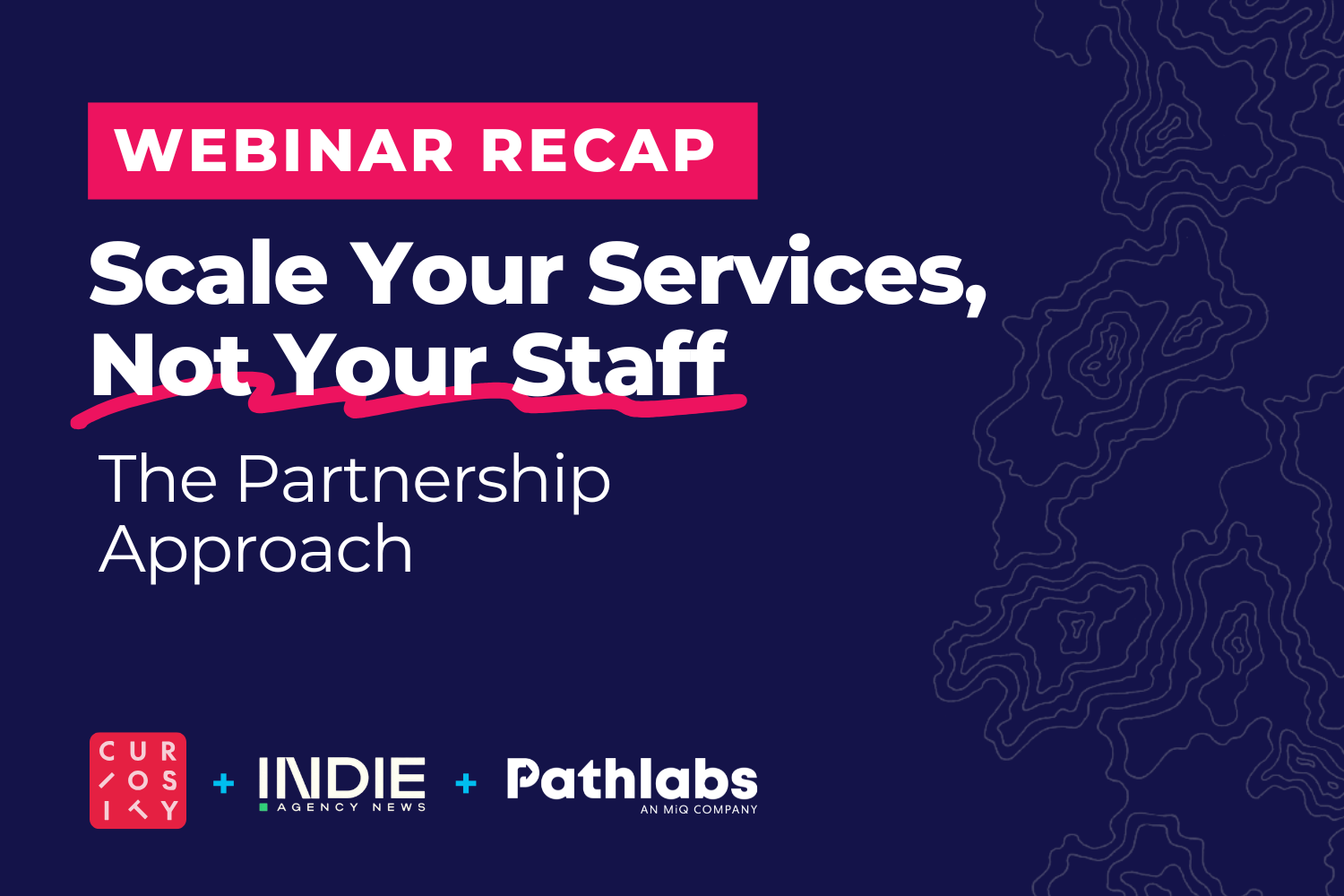How to Build a First-Party Data Strategy & Why You Need One
| Pathlabs Marketing |
| November 13th, 2023 |
Advertising teams who run paid digital advertising campaigns need a refresh on first-party data. In this blog, we dish it out, discussing what a first-party data strategy is, examples of data to collect, and what to keep in mind when approaching this type of data.
What Is a First-Party Data Strategy?
A first-party data strategy is a tactical plan an entity formulates to outline how it will collect, analyze, and apply first-party data in its operations and efforts.
In the context of digital paid advertising, it is common for advertising teams, agencies, and media execution partners to formulate a strategy and stance around first-party data.
For in-house advertising teams working for a single brand or business, their strategy constitutes how they collect and use the first-party data from their brand-owned touchpoints to better develop their user interface and enrich their paid digital advertising efforts.
For digital advertising agencies working for multiple brands or a media execution partner, in their case, working for numerous agencies, their strategy revolves around how they will safely access and leverage the first-party data of their individual clients and apply it when executing the clients’ paid digital advertising efforts.
“It is important to note that a first-party data strategy doesn’t merely outline which first-party data to collect and use. This strategy also outlines the tools and methodologies for data collection and team guidelines for adhering to privacy and data regulations currently in place.”
How Is 1st Party Data Different From 2nd and 3rd Party Data?
First-party data is information collected by an entity, most commonly a business or brand, directly from their audiences on their owned channels. These owned channels can include the entity’s website, mobile apps, social media profiles, customer service touchpoints, and offline interactions.
Second-party data is essentially first-party data that one entity collects and shares with another, often through partnerships or exclusive deals.
Third-party data is user data aggregated from various online sources and platforms by data brokers. These brokers collect this data and sell it to advertising teams. This data is broader in scope, often less precise, and can be less compliant with new privacy standards.
The common thread between these data types is that they all pertain to user information, and advertising teams who promote entities can use them to gain audience insights and enrich paid digital advertising campaign execution.
Examples of 1st-Party Data
There are two buckets of first-party data that advertisers need to keep in mind:
Brand and Business Collected 1st-Party Data
This is first-party data that entities like brands or businesses collect from actual users and customers engaging with their online locations or offline opportunities. These include:
Website Analytics and Data
Pages users visited, time spent on each page, actions taken, items placed in cart, wishlist information, conversion data, log-in data (if applicable).
Customer Relationship Management Data
Customer info provided, email lists, contact lists, survey responses, purchase history, interaction history, customer service records, sales pipeline data.
Social Media Engagement Data
Likes, follows, poll results, subscriptions, reposts, direct message threads.
Offline Data
Physical form fillouts, personal notes, comments, feedback, in-store purchase data, coupon usage.
Publisher Collected 1st-Party Data
This is first-party data collected by a publisher, such as Forbes, the New York Times, Amazon, Google, or Meta – any proprietary of a website, platform, or app. Publishers can collect most of the first-party data mentioned above, even processing it at an exponential rate due to the amount of traffic they receive.
Advertisers normally cannot access the first-party data that publishers collect. Publishers primarily leverage this data for internal purposes like understanding the types of users and traffic their web locations receive, training their proprietary models and algorithms, forecasting future web traffic and ad inventory, and improving overall user experience.
How Is First-Party Data Collected?
Most entities collect first-party from their owned web pages, apps, and other channels using pixels, cookies, or tracking software. These connect to the touchpoints and collect data from users while they engage.
Alternatively, entities may collect first-party data using their CRM systems, email campaigns, form submissions, sign-up sheets at in-person events, or even telephone lines.
“When entities – brands and businesses – hire advertising agencies and MEPs to oversee their paid digital advertising campaign efforts, it’s typically the main entity’s responsibility to gather, refine, and manage their own first-party data.
If the entity wants the agency or MEP to leverage this data, they often have to use a third-party service to upload the data into the advertising platform the agency or MEP will ultimately use to execute the entity’s advertising campaigns. Following this process ensures the safe transfer of data to the advertising platform while the client entity retains the liability for collecting and providing the data, with proper consent.”
Why Do You Need a First-Party Data Strategy?
Access to Valuable Data
First-party data comes from users engaging with an entity’s owned channels. When advertising teams, agencies, or MEPs run paid advertising campaigns for these entities, having this audience data on hand is helpful, as it lends additional perspective around the users who have leaned in before and that they plan to target in the future. A strategy will help them collect and use this data more meticulously.
High Data Volume Management
When users engage in the different owned channels of an entity, this generates a lot of first-party data available for collection. This merits a need for a strategy for how the entity will consistently handle this volume, update it, clean it, and maintain it.
Moving to Cookieless Advertising
Google Chrome is currently depreciating third-party cookie usage, and we are seeing many additional regulations surfacing from the CCPA and GDPR laws that demand more privacy and safeguards around how advertisers track users and use their data for advertising.
This makes it much harder for advertisers to leverage cookies and, most importantly, lean on insights from third-party data. So, teams are now shifting to what they can still use: first-party data collection. Therefore, having a first-party data strategy ready to go is quite timely.
How to Use First-Party Data Effectively
When running paid digital advertising campaigns, advertising teams, agencies, and media execution partners can effectively use and apply first-party data in the following ways:
Create Customer Profiles
Teams can look at first-party data to glean insights into the target market they want to reach. They can group and segment similar users based on the data, then cater their subsequent targeting strategy around these user features.
Activate First-Party Data in Ad Platforms
When using advertising platforms to execute paid campaigns, such as Facebook Ad Manager or The Trade Desk, teams can leverage the platform’s first-party activation features, if available.
As mentioned, if an entity hires an agency or MEP, it will still have to collect and activate the first-party data. It will do so by uploading the first-party data directly into the ad platform or with the help of a data management platform like Liveramp. Once the data activates in the platform, the actual advertising team can leverage it in the following ways:
User Matching
The platform can analyze the first-party data by looking at device IDs, emails, or phone numbers. Then, it can match these users from the list with the actual users it has tracked internally. So, if a user is anonymized on a first-party data list via their device ID, the platform can match this device ID to what it has on file. Then, if the same user revisits the ad location, the platform can recognize them and serve them a more specific or retargeted ad.
Lookalike Audience Building
The platform can pull from the first-party data to develop a lookalike audience, a group of users with similar attributes to the original audience data provided. So, when users fit into this lookalike audience, the platform will display an ad to them.
Algorithm Training
For teams that don’t want to go the user matching or lookalike audience route, certain platforms can still ingest this first-party data, using it to enhance its algorithms when placing ads and the suggestions it generates to make the effectiveness and oversight of the advertising campaign easier for the advertiser.
Risks and Challenges of Using First-Party Data
Clean Data Management
Juggling multiple first-party data sources is challenging. A single entity might operate a website, social media accounts, and other touchpoints. Ensuring this data is clean, free of duplicates, and effectively organized requires the right expertise and often a data management platform. Many teams need more resources to manage this properly.
Brand Safety and Liability
Entities and teams must adhere to stringent regulations and laws regarding collecting first-party. These guidelines will differ based on the type of data collected and the location of the user.
External Validity
While first-party data is directly collected from users on an entity’s owned channels, it may not always represent the target audience accurately. Relying on a small data sample can also lead to incorrect assumptions about the audience.
When it comes to paid digital advertising (like paid social media, search advertising, and display campaigns), simply having first-party data doesn't guarantee its applicability to these efforts, either. Advertising teams might have to experiment or rely on the advertising platforms' algorithms and targeting features to find and engage the right users, which might not involve first-party data directly.
The Impact of Technology on First-Party Data
Advances in technology, such as data management platforms and tools like Google Tag Manager, along with developments in machine learning, are making it easier for organizations to collect, organize, and analyze first-party data.
Yet, these advancements are tempered by the growing concern for user privacy and the pushback against tracking by advertisers. The advertising industry faces a critical decision: embrace the new technology for better targeting or prioritize user privacy, which could compromise ad performance.
This tension between technology and privacy will likely remain a key topic of discussion for years to come.
How to Build Effective First-Party Data Strategies
Define Your Goals and Objectives
Before deciding which first-party data to track, teams must refer back to the overarching goals and objectives behind why they are running paid digital advertising campaign efforts in the first place. They should rely on a small selection of critical metrics and first-party data points to indicate performance, identify audiences, and gain additional insight. Just because an entity can collect first-party data from multiple sources does not mean it must leverage it all.
Identify Data Sources and the Type of Data Collected
It is important to gather data from the touchpoints, engagements, and channels the entity invests significant effort and budget into and that indicate the target audience. The accuracy and traceability of this data are paramount, so spend extra time ensuring both.
Along these lines, regardless of who collects the first-party data, they must inform themselves of all existing regulations and guidelines. Since data collection and usage rules frequently change, staying current is crucial. This proactive approach helps prevent any potential legal or ethical issues that could arise from non-compliance.
Offer Value in Exchange for Data
Although advertising agencies and media execution partners don’t often play a role in managing these efforts, advertising teams for entities can consider additional ways to obtain first-party data by offering discounts, surveys with prizes, or loyalty programs. These incentives encourage users to provide first- or zero-party data while receiving value in return.
In Conclusion…
First-party data is the valuable information collected directly from an entity's audience, offering unparalleled insights and a competitive edge in tailoring digital advertising efforts. A first-party data strategy is a comprehensive plan that guides how this data will be gathered, analyzed, and utilized effectively and responsibly. Given the dynamic nature of the digital landscape—where consumer behaviors, technological capabilities, and privacy regulations are in constant flux—it is time to have a flexible yet robust first-party data strategy, even if that strategy is to avoid using it.










